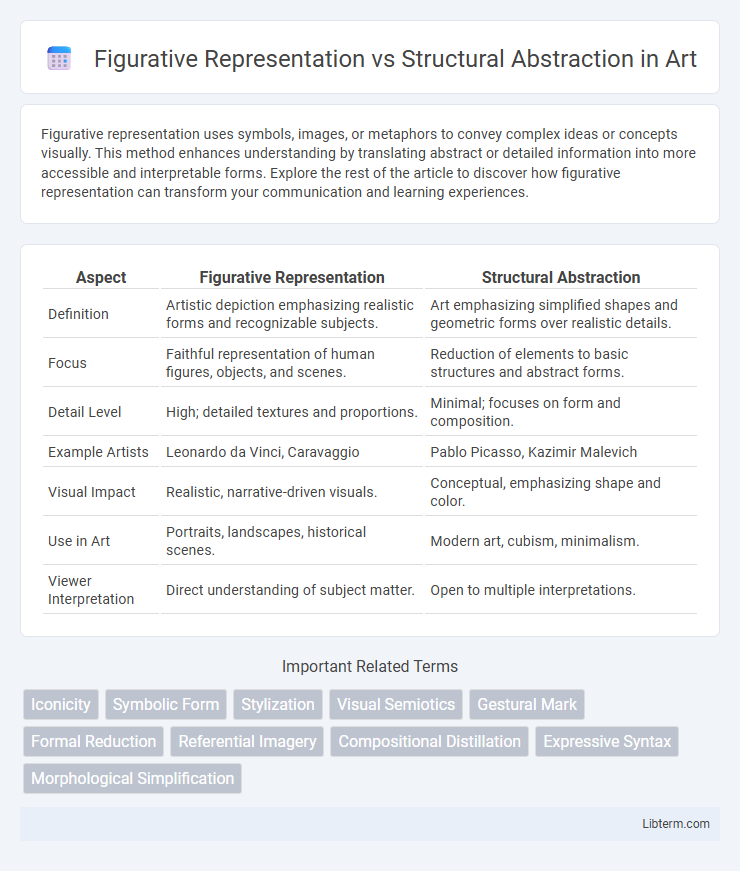Figurative representation uses symbols, images, or metaphors to convey complex ideas or concepts visually. This method enhances understanding by translating abstract or detailed information into more accessible and interpretable forms. Explore the rest of the article to discover how figurative representation can transform your communication and learning experiences.
Table of Comparison
| Aspect | Figurative Representation | Structural Abstraction |
|---|---|---|
| Definition | Artistic depiction emphasizing realistic forms and recognizable subjects. | Art emphasizing simplified shapes and geometric forms over realistic details. |
| Focus | Faithful representation of human figures, objects, and scenes. | Reduction of elements to basic structures and abstract forms. |
| Detail Level | High; detailed textures and proportions. | Minimal; focuses on form and composition. |
| Example Artists | Leonardo da Vinci, Caravaggio | Pablo Picasso, Kazimir Malevich |
| Visual Impact | Realistic, narrative-driven visuals. | Conceptual, emphasizing shape and color. |
| Use in Art | Portraits, landscapes, historical scenes. | Modern art, cubism, minimalism. |
| Viewer Interpretation | Direct understanding of subject matter. | Open to multiple interpretations. |
Introduction to Figurative Representation and Structural Abstraction
Figurative representation captures subjects with recognizable forms and realistic details, enabling clear visual understanding and emotional connection. Structural abstraction emphasizes geometric shapes and patterns, reducing objects to their fundamental forms to highlight underlying structure and design principles. Both approaches serve distinct purposes in art, balancing depiction and interpretation through their unique visual languages.
Defining Figurative Representation in Art
Figurative representation in art involves depicting objects, people, or scenes in a recognizable and realistic manner, closely resembling their real-world appearance. This style emphasizes accurate anatomy, perspective, and detail to convey identifiable subjects and narratives. Unlike structural abstraction, figurative art prioritizes lifelike portrayal over simplified forms or geometric interpretations.
Understanding Structural Abstraction
Structural abstraction involves simplifying complex systems by focusing on essential relationships and patterns rather than detailed figurative elements. It enables clearer understanding of underlying frameworks by distilling intricate data into conceptual models. This approach enhances cognitive processing and problem-solving by emphasizing core structures over surface-level appearances.
Historical Evolution of Both Approaches
Figurative representation evolved prominently during the Renaissance, emphasizing realistic human forms and naturalistic detail to convey narrative and emotion. Structural abstraction emerged in the early 20th century, influenced by Cubism and Constructivism, prioritizing geometric shapes and simplified forms to explore underlying structures and spatial relationships. Both approaches reflect shifting artistic priorities: figurative art's focus on mimetic accuracy contrasts with abstraction's intent to dissect and reinterpret reality through formal elements.
Key Artists and Movements
Key artists in figurative representation include Caravaggio, Rembrandt, and Lucian Freud, whose works emphasize realistic human forms and emotional depth. Structural abstraction is prominently represented by artists such as Piet Mondrian, Kazimir Malevich, and Wassily Kandinsky, who focus on geometric shapes, lines, and color theory to convey meaning beyond literal depiction. Movements like Renaissance and Baroque are linked to figurative representation, while De Stijl, Suprematism, and Abstract Expressionism epitomize structural abstraction.
Visual Elements and Techniques
Figurative representation emphasizes realistic visual elements such as detailed shapes, colors, and textures to depict recognizable subjects, relying on techniques like shading, perspective, and accurate proportions. Structural abstraction focuses on simplifying or distorting these elements into geometric shapes, patterns, or symbolic forms, using techniques like fragmentation, stylization, and exaggeration to convey underlying structures or emotions. Both approaches manipulate visual components to create meaning, with figurative art grounded in observable reality and structural abstraction highlighting conceptual or formal qualities.
Emotional and Conceptual Impact
Figurative representation captures detailed, recognizable elements that evoke immediate emotional responses through vivid imagery, fostering personal connections and empathy. Structural abstraction emphasizes simplified forms and essential relationships, engaging viewers intellectually by encouraging interpretation and highlighting conceptual frameworks. The emotional resonance of figurative art contrasts with the thought-provoking nature of structural abstraction, each offering distinct pathways to understanding and experiencing art.
Cultural and Contextual Influences
Figurative representation directly depicts recognizable subjects influenced by cultural narratives and historical context, making it highly sensitive to symbolic meanings within specific societies. Structural abstraction emphasizes shapes, patterns, and forms detached from literal interpretation, reflecting broader cultural shifts towards conceptual thinking and modernist aesthetics. Both approaches reveal how cultural values and contextual factors shape artistic expression, with figurative works rooted in tradition and structural abstractions aligned with innovation and universal themes.
Figurative vs Structural: Contemporary Perspectives
Figurative representation emphasizes realistic, recognizable forms that closely mirror the natural world, fostering emotional and narrative engagement through detailed imagery. Structural abstraction, in contrast, prioritizes geometric shapes, patterns, and spatial relationships to explore underlying forms and conceptual frameworks beyond visual likeness. Contemporary perspectives highlight a dynamic interplay between these approaches, where artists blend figurative cues with abstract structures to challenge perceptions and evoke complex interpretations.
Conclusion: Bridging the Artistic Divide
Figurative representation captures the visual reality through detailed imagery, while structural abstraction emphasizes underlying forms and relationships, offering diverse cognitive engagement. Bridging the artistic divide involves integrating both approaches to enrich interpretation and emotional resonance. This synthesis fosters a multidimensional art experience, enhancing viewer connection through balanced visual storytelling and conceptual depth.
Figurative Representation Infographic

 libterm.com
libterm.com